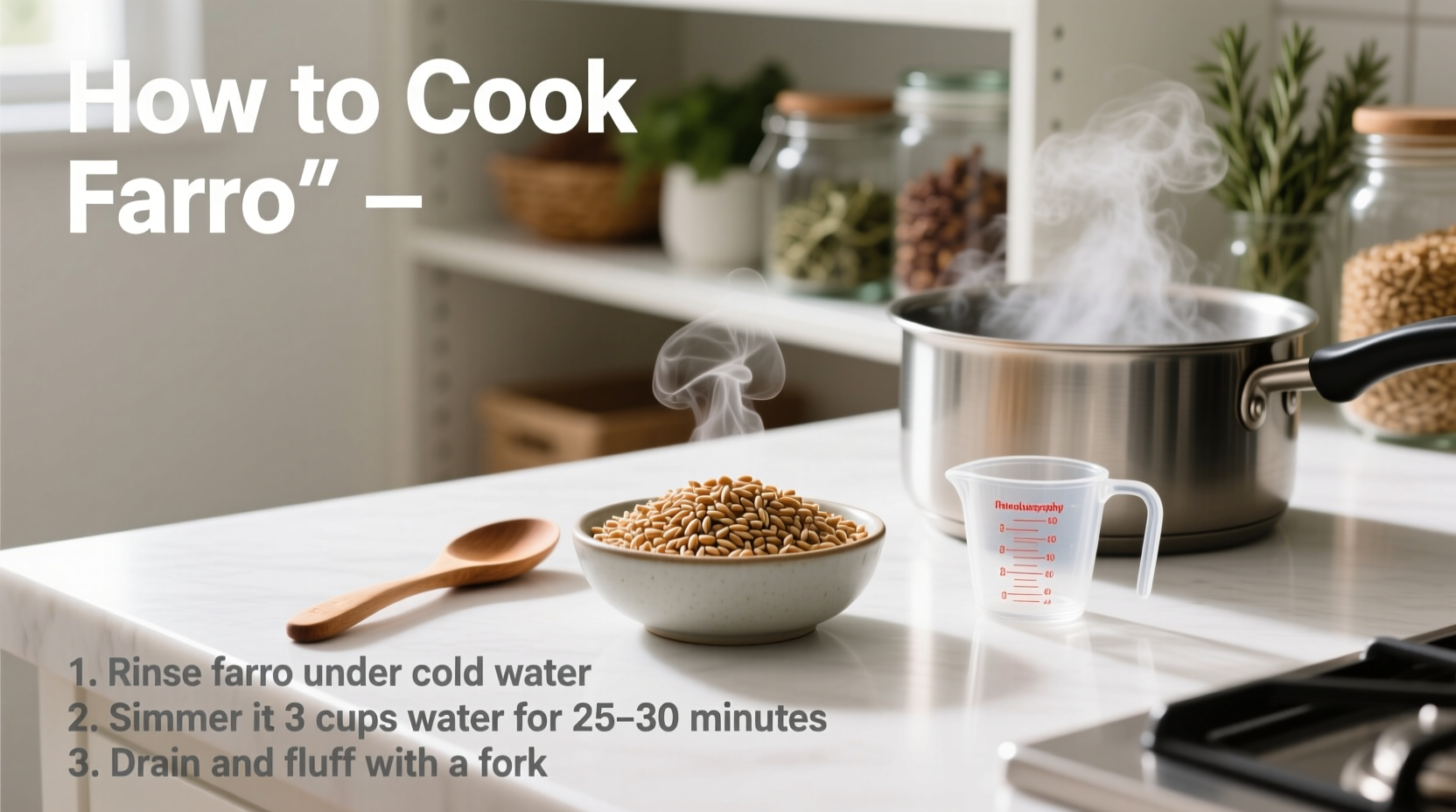Perfectly cooked farro requires a 1:2.5 water-to-grain ratio, 25-30 minutes simmering time for semi-pearled varieties, and a final texture that's tender yet pleasantly chewy. Rinse first, toast optionally, simmer gently, and let rest covered for best results.
Unlock the nutty flavor and satisfying chew of perfectly cooked farro with this chef-tested method trusted by home cooks for over a decade. Whether you're meal prepping for the week or creating an elegant grain bowl, mastering farro cooking transforms your kitchen confidence and expands your healthy cooking repertoire significantly.
Why Farro Deserves a Permanent Spot in Your Pantry
Farro isn't just another trendy ancient grain—it's a nutritional powerhouse with roots tracing back to Bronze Age civilizations. This wheat relative delivers 8 grams of protein and 7 grams of fiber per cooked cup, plus essential minerals like magnesium and zinc. Unlike refined grains, farro maintains its bran and germ, providing sustained energy without blood sugar spikes. Modern nutrition research from the Harvard T.H. Chan School of Public Health confirms that regular whole grain consumption correlates with reduced risk of heart disease and type 2 diabetes.
| Farro Type | Hull Removal | Cooking Time | Water Ratio | Texture Result |
|---|---|---|---|---|
| Pearled | Complete hull removal | 15-20 minutes | 1:2.5 | Soft, uniform |
| Semi-Pearled | Partial hull removal | 25-30 minutes | 1:3 | Chewy with nutty flavor |
| Whole | No hull removal | 40-60 minutes | 1:3.5 | Firm, rustic texture |
Your Farro Cooking Timeline: From Pan to Plate
Follow this precise sequence for foolproof results every time. Professional kitchens use this same method whether preparing single servings or banquet quantities:
- Prep (5 minutes): Rinse 1 cup farro under cold water using a fine-mesh strainer. Remove debris while preserving the grain's integrity.
- Toasting (Optional but recommended): Heat grains in dry saucepan 3-5 minutes until fragrant. This enhances nuttiness without burning.
- Liquid Addition: Combine with 2.5 cups water or broth. Add ½ tsp salt and optional aromatics like garlic or bay leaves.
- Simmering: Bring to boil, then reduce to gentle simmer. Cover and cook 25-30 minutes for semi-pearled variety.
- Resting: Remove from heat. Let stand covered 10 minutes—this crucial step completes cooking through residual heat.
- Fluffing: Gently separate grains with fork. Excess moisture evaporates during this final stage.
Avoid These 3 Common Farro Cooking Mistakes
Even experienced cooks stumble with farro's unique requirements. Sidestep these pitfalls for restaurant-quality results:
- Skipping the rinse: Raw farro often contains dust and loose starches that create gummy texture if not washed away
- Overcooking: Unlike rice, farro shouldn't become mushy—aim for al dente with slight resistance when bitten
- Ignoring resting time: Cutting corners here leads to uneven texture and watery grains

How to Know When Farro Reaches Perfect Doneness
Texture trumps timing when cooking farro. Start checking 5 minutes before expected finish time:
- Visual cue: Grains should have visibly puffed but maintained distinct shape
- Tactile test: Press between fingers—they should yield slightly but retain firmness
- Taste test: Sample a few grains—they must be tender yet pleasantly chewy
Undercooked farro feels hard in the center, while overcooked becomes mushy and loses its characteristic bite. Remember that farro continues cooking off-heat during resting, so slightly underdone is better than perfect when removing from stove.
Storage Solutions for Cooked Farro
Maximize your cooking efficiency with proper storage techniques:
- Refrigeration: Store in airtight container for up to 5 days—add 1 tsp olive oil to prevent sticking
- Freezing: Portion into 1-cup servings in freezer bags (keeps 3 months)
- Reheating: Sprinkle with water and microwave 60-90 seconds, or sauté with broth for restaurant-style revival
5 Delicious Ways to Serve Your Perfectly Cooked Farro
Elevate your farro beyond basic side dishes with these chef-approved combinations:
- Mediterranean Power Bowl: Toss with roasted vegetables, kalamata olives, feta, and lemon-tahini dressing
- Breakfast Porridge: Simmer with almond milk, cinnamon, and fresh berries for hearty morning meal
- Farro Risotto: Substitute for Arborio rice in traditional risotto preparation method
- Salad Base: Mix with chickpeas, cucumber, mint, and sumac vinaigrette
- Soup Thickener: Add to minestrone or vegetable soups during last 10 minutes of cooking
Special Cooking Methods Worth Trying
Adapt your technique based on equipment and time constraints:
- Rice cooker method: Use 1:2.5 ratio, select "brown rice" setting for semi-pearled varieties
- Instant Pot shortcut: 15 minutes high pressure + 10 minute natural release for semi-pearled farro
- Oven-baked technique: 350°F for 30 minutes covered, ideal for large batches with even cooking
Each method has specific context boundaries—rice cookers work best with pearled farro, while Instant Pot dramatically reduces cooking time for whole varieties. Choose based on your grain type and desired texture outcome.
Troubleshooting Your Farro Results
Fix common issues with these quick solutions:
- Too watery: Return to stove uncovered for 2-3 minutes to evaporate excess liquid
- Too dry: Stir in 2 tbsp hot water and let stand 5 minutes
- Burnt bottom: Immediately transfer to clean bowl—top portion remains usable
- Undercooked: Add ¼ cup hot water and continue simmering 5-10 minutes











 浙公网安备
33010002000092号
浙公网安备
33010002000092号 浙B2-20120091-4
浙B2-20120091-4